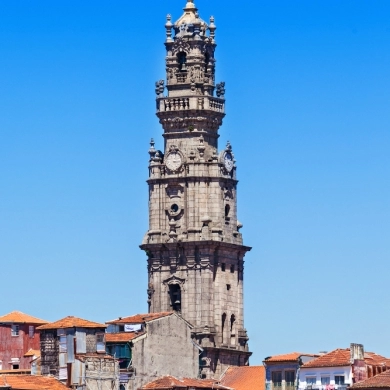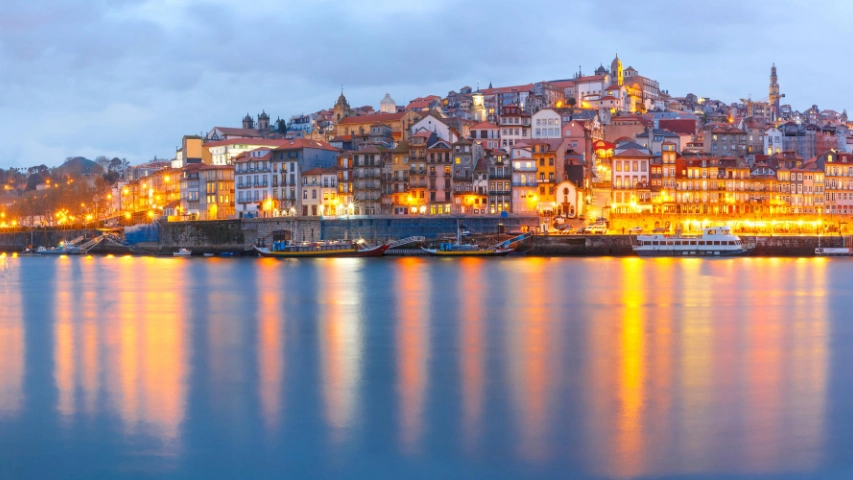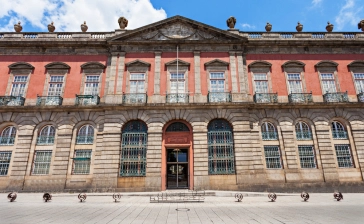Porto is a city located on the northwestern coast of Portugal, where the Douro River meets the Atlantic Ocean. With a population of around 230,000 people in the city and almost 3 million in its metropolitan area, Porto is the second largest city in Portugal after Lisbon.
Despite its rich history, Porto has modernized greatly in recent decades and has made great strides in terms of accessibility, especially for those using wheelchairs. The city is famous for producing port wine, but it also offers numerous attractions, such as narrow cobblestone streets with merchants' houses and cafes, the Church of San Francisco, the 19th-century Stock Exchange Palace, its bridges, the Clérigos tower, and its historic center, designated a UNESCO World Heritage Site since 1996.
Porto's metro system is the longest in Portugal and serves the city center and its metropolitan area, as well as its recently renovated airport, which has a capacity of over 15 million passengers a year.
Lisbon and Porto have always had a competitive relationship, with Porto often referred to as having a British air due to the settlement of English wine merchants. The saying goes that "Lisbon has fun while Porto works." The famous wine cellars are located on the southern bank of the Douro River, but are now in the municipality of Vila Nova de Gaia, not Porto.
As the capital of northern Portugal, Porto offers accessible beaches, excursions, theme parks, restaurants, and more for visitors with reduced mobility. Enjoy your stay in this accessible and fascinating city!
In Porto, there are several tourist offices that can provide information on various activities, hotels, transportation options, tips, and anything else you need to fully explore the city. The staff at these tourist offices speak multiple languages, and some of the most prominent offices are:
Porto Central Tourism Point and Porto Municipal Tourism Commission:
- Rua Clube dos Fenianos 25. 4000-172
- Telephone (+351) 223393470
- Email: turismo.central@cm-porto.pt
Tourism Office D. Joao I
- Praça D Joao I, 43 4000-295
- Telephone: (+351) 222057514
Infant Tourism Office
- Rua de Infante D. Henrique, 63
- Telephone: (+351) 222009770
- Email: turismo.central@cm-porto.pt
Porto Airport Tourist Office:
This office is located on the 3rd floor, before the security controls, and it can help you organize your stay in Porto, offering all kinds of services and advice so that you can make the most of your days of visit.
- Telephone: (+351) 226050880
- Email: direct@abreu.pt
At the airport there is also an interactive tourist service point and it is located before the security checkpoint, on the ground floor.
Just like many other big cities, Porto has a special tourist card called the PORTO CARD that offers transport and discounts on tickets to attractions, museums, and places of interest. The card can be purchased at the airport or any tourist office in the city, and it is recommended to buy it at the airport for convenient travel to the city center or hotel.
The card comes in four options, ranging from a 1-day option to a 4-day option, with prices starting at €13 for the 1-day option and reaching €33 for the 4-day option. The card includes unlimited access to the metro, bus, and some train lines, as well as free admission to 6 museums and 50% discounts at 14 other monuments in the city. If you purchase the card with transport included, you will receive two cards: a transport card and an attraction card.
The transport card will be activated when used for the first time at any station and is valid for 24 hours. On the attraction card, you must write the time of your first use and it is also valid for 24 hours.
Airport:
The Porto airport, named "Francisco Sa Carneiro", is one of the most modern airports in Europe and is fully accessible for people with mobility issues. It is located just 12 km from Porto in the town of Maia.
The airport offers the MyWay service to assist people with reduced mobility. If you have a mobility issue and require the MyWay service, it is recommended to notify your airline or travel agency in advance to ensure everything is prepared for your arrival.
Contact:
How to get from the airport to the center:
Metro:
The trip from the airport to the city center takes approximately 30 minutes and is fully accessible for people with wheelchairs. Take line E, heading towards Estádio do Dragão. This route is direct and requires no transfers.
Line E operates daily from 06:00 to 01:00, with a frequency of every 20 minutes from Monday to Friday and every 30 minutes on weekends.
The cost of the trip is €1.85. Purchase your ticket from authorized machines and make sure to buy a valid Zone 4 (Z4) ticket, which covers the airport journey.
Bus:
The bus ride from the airport to the city center costs the same as the metro (€1.85, zone 4), but it takes longer. It can be a good alternative for travelers arriving at night when the metro is not available, or for those who prefer not to take a taxi (which is more expensive).
There are several options for bus transportation:
The first is the STCP public bus, which has several accessible buses (only buses with a wheelchair symbol are wheelchair-friendly and can only accommodate one wheelchair per bus). Lines 601, 602 travel between the airport and Cordoaria, while line 604 travels to Sao Joao hospital. These buses run every 20 to 30 minutes throughout the day and take between 50 minutes and 1 hour, depending on traffic.
For those arriving at the airport at night and needing to get to Porto, the 3M bus provides a connection from the airport to Avenida dos Aliados, where you can then take the metro.
Express bus:
There are several companies that offer express bus service from the airport to the city center. Two of the most popular options are:
- Transdey: This company provides a shuttle service from Porto Airport to the Gare Rodoviaria bus station for around €5.
- GoingPorto: This service travels from Porto Airport to the city center, with a stop in Boavista, from where you can catch a bus to various parts of the city. The final destination is Aliados in the historic center, and the cost is around €9.
For more information, contact: (+351) 918745870.
It is recommended to arrive at the stop 15 minutes before your scheduled departure time.
Taxi:
Taxis are undoubtedly the most expensive transportation option, but they are also the most comfortable. Taxis are available outside the airport terminal, and there is a company that provides taxis equipped for people with disabilities. (Reserving in advance is recommended to avoid any unexpected charges upon arrival). The average cost of the trip from the airport to the city center is around €30, but it may be slightly higher on weekends or during nighttime hours.
Contact:
Transport within the city:
Train:
The main train station in Porto is São Bento Station, which is fully accessible for people with mobility issues, but can only be entered from the side.
São Bento is located in Almeida Garrett Square and is famous for its stunning tile panels depicting historical events, making it worth a visit just to see this work of art.
From this station, you can travel to virtually any part of Portugal and Spain.
Comboios de Portugal (CP) offers an Integrated Mobility Service (SIM), which is available 24 hours a day, 7 days a week, with information and reservation services.
With the help of this service, people with special needs can access information about the accessibility of trains and stations, as well as assistance for boarding and disembarking trains.
Contact:
- Telephone: (+351) 707 210 746
- Web: www.cp.pt
Metro:
The metro in Porto is 100% adapted and accessible in all its stations, either it is at street level or it has ramps and lifts. The place reserved for wheelchairs is in the first car. The ticket is purchased at the vending machines at the station, they have a price of €1.20 and are validated before entering. It is the best option to move around the city and also to and from the airport, but remember that the Porto metro does not have many stops in the most touristic areas of the city.
In Porto there are 6 lines and 81 metro stops
- Line A (blue): Estádio do Dragão - Senhor de Matosinhos.
- Line B (red): Estádio do Dragão - Póvoa de Varzim.
- Line C (green): Estádio do Dragão - ISMAI.
- Line D (yellow): Hospital São Joã - Santo Ovídeo.
- Line E (purple): Estádio do Dragão - Aeroporto
- Line F (orange): Fânzeres - Senhora da Hora.
The most important station of the metro network and where you can transfer to line D (yellow) is Trinidade.
Taxi:
In Porto there are taxis adapted for people with reduced mobility. The new taxis adapted for the transport of people with reduced mobility are equipped with boarding platforms, adapted seat belts, wheelchair fixation devices and a door with an upper opening angle. These taxis are available at airport ranks or by requesting them from taxi stations.
We offer you a company that has several adapted vehicles and provides 24-hour service in Porto.
Contact:
- Radi Taxis
- Telephone: (+351) 225073900 or (+351) 917555085
- Email: info@raditaxis.pt
The first thing you should know is that the water is cold, we are in the north of Portugal and we have the Atlantic in front of us. Portugal is famous for being a beach destination for the beaches of the Algarve, but the Algarve is more than 500 km from Porto!
Porto's beaches are perfect for sunbathing, drinking some caipirinhas and if you don't mind the cold, you can try the water.
The beaches have a lifeguard during the high season, between June 15 and September 15.
Here we detail some of the wheelchair accessible beaches in Porto, and one of the best known is La Praia do Homem do Leme, and another is Praya Azul, both are north of the Douro River, but within the radius of the city, are urban beaches.
In addition to Praia do Homem do Leme and Praia Azul, there are several other beaches in the Porto area that are accessible for people with mobility problems. Some of these include:
- Praia de Matosinhos
- Praia do Cabo do Mundo
- Praia do Ourigo
All of these beaches have ramps and other facilities that make it easier for people with mobility problems to access the sand and water. It is always advisable to check in advance with the local municipality or tourist office to confirm the level of accessibility of each beach and its facilities.
Praia do Homem do Leme:
This beach has good access to the bathing area, and is accessible to people in wheelchairs, it also has adapted toilet facilities and an accessible first aid station.
To access the beach you can arrive by private car, taxi or bus, the bus lines that will leave you in front of the beach are: 200, 202, 203 and 500, you just have to get off at the stop called Homem do Leme.
Restaurants and bars: In this you will find a bar called Bar Homem do Leme, and a few meters away you will find CaipiCompany, a cafe famous for its caipirinhas, which we highly recommend.
Praia Azul:
This beach is also accessible and has good access to the bathing area for people in wheelchairs. It has adapted toilet facilities and a lifeguard service during the high season. To get to this beach, you can take bus line 503 and get off at the Praia Azul stop.
In terms of food and drinks, there are several options along the promenade, including restaurants and cafes that offer a variety of dishes and drinks. You can try a traditional seafood dish or enjoy a refreshing drink while admiring the stunning views of the Atlantic Ocean.
Services offered:
- Blue flag
- Quercus Gold Award for Quality
- Accessible beach with amphibious chair
- guarded beach
- support bar
- tent rental
- showers
- Sanitary
Historical City Center:
When visiting Porto, a walk through its historic town is a must. The city is easily accessible with well-paved and well-preserved streets and sidewalks. Despite maintaining its historic style, Porto is undergoing renovations and has become a popular tourist attraction both during the day and night. It's worth noting that the historic center was declared a UNESCO World Heritage Site in 1996.
We suggest taking a tour of the La Baixa de Porto area, starting at Avenida dos Aliados and the Praça da Liberdade, where you can admire the equestrian statue of Pedro IV from the 19th century. Also in this square is the São Bento station at Praça Almeida Garrett, where you can see historical motif tiles in the station lobby. From there, we continue down Rua das Flores, lined with goldsmith shops and the exuberant baroque façade of the Misericordia church.
The outskirts of the historic center offer lively streets filled with shops and cafes, including the famous Café Majestic and the bustling and colorful Bolhão market. We then move on to São Felipe Néry street, where we find the Church and Tower de los Clérigos. Finally, a visit to the Lello bookstore is a must, with its stunning wooden décor.
Astoria Restaurant https://astoriarestaurante.com/pt-pt/
Astoria Restaurant is located in the Palacio das Cardosas, dating back to 1911, and is renowned for its prime location, innovative and modern cuisine, and high-quality ingredients.
Adhering to the "Farm to Table" concept, the restaurant prioritizes the use of organic and locally sourced Portuguese products in season, supporting local suppliers and farmers.
At the Hotel InterContinental Porto - Palacio das Cardosas, Astoria Restaurant offers a vibrant and colorful dining experience, perfectly fitting with the surrounding area of Porto.
The restaurant is also accessible, including its bathrooms.
Address and contact:
- Praça da Liberdade 25. 4000-322 Porto
- Telephone: (+351) 220035639
- Email: restaurant.astoria@ihg.com
Beher Restaurant https://www.beherportugal.com/
Beher Restaurant, of Spanish origin, is run by the fourth generation of the Hernandez family from Guijuelo, who are experts in cured meats, particularly Iberian ham. However, their fried eggs and other specialties are also highly recommended.
The restaurant is accessible, but its bathrooms are not.
Address and contact:
- Rua Sa Da Bandeira 589 Porto, Portugal
- Telephone: (+351) 917283571 or (+351) 925561971
- Email: oporto@beherstores.com
Clerigos Tasting Room https://clerigostastingroom.com/
Clerigos Tasting Room is located in a prime spot between the Torre dos Clérigos and the Lello Bookstore, two major landmarks of the city. Here, you can savor Port wines from Casas Taylor, Fonseca, and Croft, paired perfectly with sweet and savory pastries. It is a place that can be visited at any time of the day, with take-out options available, but you can also choose to have a drink or a full meal.
The restaurant is accessible, but its bathrooms are not.
Address and contact:
- Rua das Carmelitas – Passeio dos Clérigos 151 Loja A1 4050-162 Porto
- Telephone (+351) 932091603








